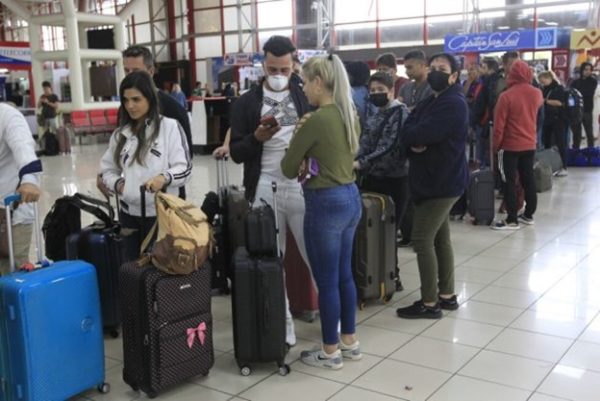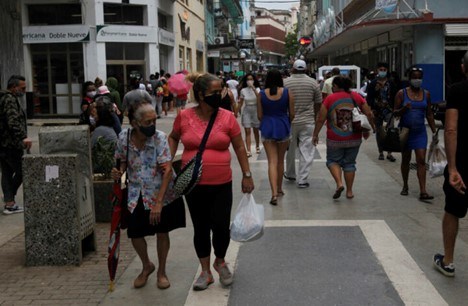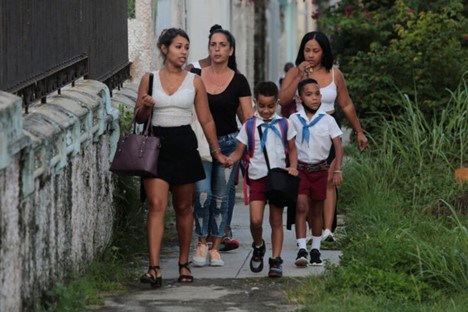Growing Female Exodus from Cuba Poses New Challenges

HAVANA TIMES – Emigrating from Cuba was an agonizing decision for Ana Iraida. She left behind family and friends; in her backpack she carried many hopes, but also the fear of facing dangers on the journey to the United States.
“My salary and that of my second job, as an editor, were insufficient. I wanted to prosper and help my parents. Nor did I want to have a child in a country where it is an ordeal to buy everything from disposable diapers to soap, not to mention food,” the 33-year-old philologist who, like the others interviewed for this story, asked to withhold her last name, told IPS.
After selling her apartment in Havana, she left for Nicaragua in December 2022.
“The journey. I could have been robbed of my money, raped or even murdered. Almost two years ago, when the airports reopened after the COVID pandemic, some young women who lived near my house left and their families never heard from them again.” — Ana Iraida
“Some friends lent me the rest of the money I needed. I reached Mexico by land. I paid 1,800 dollars to be taken to the (U.S.) border. I crossed and turned myself in to the border patrol in Yuma, Arizona, on New Year’s Day,” the young woman said from Houston, Texas, where she now lives.
Estimates put the number of Cubans who emigrated in 2022 at 300,000. Of these, some 250,000 attempted to reach the United States, the country that receives the largest inflow of Cubans and that is only 167 kilometers from Cuba across the Straits of Florida.
The increase in the exodus from this Caribbean island nation of 11 million people is happening against a backdrop of a worsening economic crisis, fueled by COVID, the stiffening of the U.S. embargo, partial dollarization, waning purchasing power of salaries and pensions, shortages of essential products and inflation.
Added to this are failures and delays in the implementation of a set of reforms to modernize the country, approved in 2011, and the unsuccessful implementation of monetary reforms since January 2021.
Local officials here argue that the U.S. Cuban Adjustment Act – known as the “wet foot, dry foot policy” – in force since 1966, encourages the exodus, since it made all Cubans eligible for permanent residency a year and a day after setting foot in U.S. territory.
In the past, the rule benefited all Cubans who set foot on U.S. soil. But since January 2017 it only applies to those who have entered the country legally.
However, the flow of Cubans into the U.S. slowed after President Joe Biden’s administration adopted on Jan. 5 a temporary humanitarian residency permit program known as parole, similar to the one implemented in October 2022 for Venezuelans and previously for people of other nationalities.
As of the end of July, more than 41,000 Cubans had obtained temporary parole, 39,000 of whom had already reached the country, the U.S. Customs and Border Protection (CBP) reported on Aug. 18.
In addition, after a four-year freeze, on Jan. 4 the U.S. Embassy in Havana resumed processing immigrant visas, a decision that the Cuban government welcomed as a “necessary and correct step” aimed at guaranteeing regular, orderly and safe migration.

Risks and impacts
International organizations and human rights groups warn of the risks faced by immigrants en route, especially women, children and the elderly, who are more likely to become victims of abuse, mistreatment, discrimination, extortion, kidnapping and sexual violence by organized crime groups.
“The journey was stressful,” said Ana Iraida. “I could have been robbed of my money, raped or even murdered. Almost two years ago, when the airports reopened after the COVID pandemic, some young women who lived near my house left and their families never heard from them again.”
Other migrants never reach their destinations and remain trapped in transit countries in overcrowded conditions or as victims of violence.
I was also worried “that they would detain me and send me back to Cuba, and that in the end I would have no home to return to, and be in debt,” added Iraida.
According to the International Organization for Migration (IOM), women account for 48 percent of international migrants worldwide and an increasing number are migrating independently, including as heads of households, in search of new opportunities, to join their families or to help relatives in their home countries.
Research indicates that this phenomenon, known as the feminization of migration, generates significant impacts on demographic, physical, economic, cultural and gender indicators in regions and countries.

Cuba’s January 2013 immigration reform eliminated the requirement for exit permits and letters of invitation for nationals residing on the island, extended from 11 to 24 months the time they could stay abroad without losing residency, and repealed legislation that allowed the confiscation of assets of those who left the country.

Subsequent regulations have also favored increased travel abroad for personal reasons and the possibility of living temporarily or permanently outside the country, opening the doors to a better relationship with the Cuban exile community.
Women make up a majority of those seeking temporary residence abroad, while men are a majority among those who decide to live abroad permanently, revealed the report of the National Migration Survey (Enmig 2016-2017), published by the National Bureau of Statistics and Information (Onei) in January 2019.
The survey found that 59 percent of the men and 45 percent of the women who decided to live temporarily or permanently in another country did so “to improve their economic conditions.”
In the case of women, “getting closer to or visiting family”, “supporting or caring for family members” and “helping their family here” (35 percent) are the most important motives, while they were the main motives for only 21 percent of the men.
Focusing on care
Researchers have called for more attention to be paid to the relationship between the feminization of migration and the burden of care.
In the case of Cuba, they say, migration itself often becomes a complementary strategy to face the problems associated with caregiving.
The economic crisis, the aging demographic and the emigration of young people and professionals are placing additional obstacles on caregivers to provide food, buy medicines and manage supplies.
“I moved to Ecuador seven years ago,” Betsy, a 38-year-old teacher, told IPS from the city of Guayaquil. “My two children were born here. My work makes it possible for me to send money, medicines and other products to Cuba to take care of my 80-year-old father, who has senile dementia. Otherwise, it would be very difficult for my older sister to provide adequate care for him.”
In Cuba, 22.3 percent of the population is over 60 years of age, and by 2025 it is estimated that one in four of the island’s residents will be an older adult.
The National Gender Equality Survey, published in 2019, showed that Cuban women spend an average of 14 hours more than men on unpaid work per week, which includes caring for the elderly, chronically ill and dependent persons, as well as helping children and adolescents with their homework.
For its part, the 2017 National Survey of Population Aging (Enep), whose data came out in 2020, showed that about 68 percent of those who provide care are women and most are over 50 years old.
In the case of needing care, more than 57 percent of the population over the age of 50 prefers to receive it from women, according to the study.
“I chose to stay and live in Canada almost two years ago,” said Rocio from Halifax, the capital of the Canadian province of Nova Scotia. “It has been an ordeal, but I have no regrets. It’s a way to help my 11-year-old son and my retired parents, who are taking care of him until we can be together again.”
The 40-year-old translator, who lived in the eastern Cuban city of Holguín, told IPS that “with my salary, my son and I were living on a tight budget. I could hardly help my parents, whose pensions barely covered the household bills, medicines and the few foodstuffs they could afford. I am far away, I suffer from the separation, but every month I can send them money so that they can live more comfortably and eat better.”
Increasingly young and female-dominated emigration is challenging national development plans on a sustainable basis.
“This situation calls for further research and public debate on the present and future impacts of demographic dynamics such as migration and aging as they relate to the social organization of caregiving on the island,” argues Cuban sociologist Elaine Acosta.
In the opinion of Acosta, executive director of “Cuido60, Observatory of aging, care and rights”, there is an urgent need “to accelerate and deepen structural reforms so that migration ceases to be a daily survival strategy and, at the same time, to obtain the necessary resources to implement appropriate and integrated social policies to face the current and future challenges of aging.”
Read more from Cuba here on Havana Times





